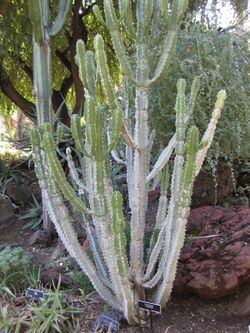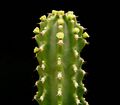Biology:Euphorbia royleana
| Euphorbia royleana | |
|---|---|

| |
| Scientific classification | |
| Kingdom: | Plantae |
| Clade: | Tracheophytes |
| Clade: | Angiosperms |
| Clade: | Eudicots |
| Clade: | Rosids |
| Order: | Malpighiales |
| Family: | Euphorbiaceae |
| Genus: | Euphorbia |
| Species: | E. royleana
|
| Binomial name | |
| Euphorbia royleana Boiss.
| |
| Synonyms[1] | |
|
Euphorbia pentagona Royle | |
Euphorbia royleana is a species of flowering plant in the family Euphorbiaceae.[1] It is also known as Sullu spurge, and Royle's spurge. It is a succulent and almost cactus like in appearance although unrelated. It grows right across the Himalaya mountains from Pakistan, India, Bhutan, Myanmar, Nepal to western China, It prefers dry and rocky slopes between 1000 and 1500 meters, but has been found up to 2000 meters. Flowering and fruiting is in spring to early summer (March–July) and seeding is in June–October. It is used as a hedging plant in northern India and has medicinal uses.
Description
Euphorbia royleana is a deciduous, cactus-like, shrub or small upright trees up to 2-5(-7) m high, which is armed with short prickles along its stems. It has a stout trunk and is glabrous except for the flowers (cyathia). The cyathia are small greenish-yellow, 3-4 appear in almost stalkless clusters in leaf axils .[2]
It has succulent segmented branches in whorls, which are green, 4-7(-8) cm thick, with branching from the upper parts. The stems have ribs 5(-7), angles more or less undulately winged with rounded teeth/tubercles. It has stout tap roots.[2]
The stems become leafless during hot and cold seasons and the leaves are alternate, apically clustered. They are produced in the moist season and soon fall. They are usually not seen when in flower. The leaf blade is fleshy oblanceolate, spathulate, or spoon-shaped 5-15 long, 1–4 cm wide and slightly succulent. The base is attenuate, the margin entire, and the apex obtuse or subtruncate. Veins are inconspicuous. The petiole is absent.[2]
Stipular spines are present in small in pairs on the edges on distinct shield, with broad flat faces between, 3–5 mm long.[2]
The cyathia, or false flowers, are greenish-yellow, almost stalkless, 3-4 in subterminal cymes in leaf axils. They are peduncle about 5 mm long. Cyathophylls as long as involucre, membranous. Involucre ca. 2.5 × 2.5 mm. Nectar-glands 5, transversely elliptic, dark yellow. Seed capsules are trigonous, 1-1.2 × 1-1.5 cm, light reddish brown, smooth and glabrous. The seeds themselves are 3-3.5 × 2.5–3 mm, brown, adaxially striate; caruncle absent.[2]
Medicinal use
It is a medicinal shrub used in Nepal locally known as siyuri or siudi. Its latex has purported molluscicidal properties.
Several researchers have noted that Euphorbia royleana has been observed growing near rock face collection sites of the Ayurvedic resin shilajit in the Himalayas. The plant is the likely origin of shilajit as its gum has a similar composition to the resin. [3]
Gallery
References
- ↑ 1.0 1.1 "Euphorbia royleana Boiss.". The Trustees of the Royal Botanic Gardens, Kew. n.d.. https://powo.science.kew.org/taxon/urn:lsid:ipni.org:names:348095-1.
- ↑ 2.0 2.1 2.2 2.3 2.4 LLIFLE - Encyclopedia of living forms "Euphorbia royleana" Text available under a CC-BY-SA Creative Commons Attribution License. www.llifle.com 14 Nov. 2005. 28 Oct 2016. </Encyclopedia/SUCCULENTS/Family/Euphorbiaceae/32938/Euphorbia_royleana> http://www.llifle.com/Encyclopedia/SUCCULENTS/Family/Euphorbiaceae/32938/Euphorbia_royleana
- ↑ Lal, VK; Panday, KK; Kapoor, ML (1988). "Literary Support To The Vegetable Origin Of Shilajit". Ancient Science of Life 7 (3–4): 145–8. PMID 22557605.
Wikidata ☰ Q5410558 entry
 |






